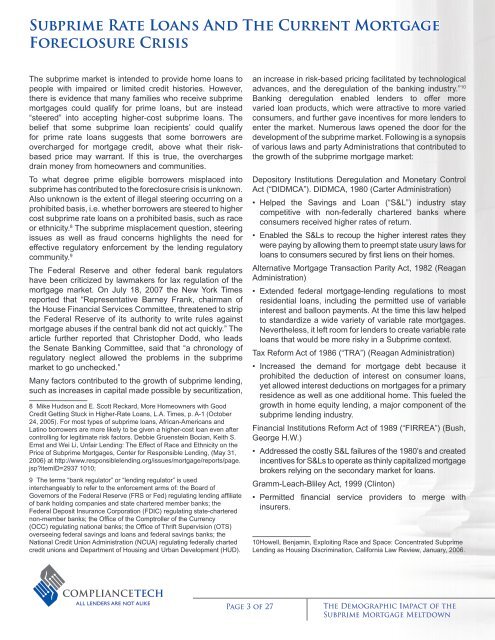Download Conference Presentations - Mortgage Lending Industry ...
Download Conference Presentations - Mortgage Lending Industry ...
Download Conference Presentations - Mortgage Lending Industry ...
You also want an ePaper? Increase the reach of your titles
YUMPU automatically turns print PDFs into web optimized ePapers that Google loves.
Subprime Rate Loans And The Current <strong>Mortgage</strong><br />
Foreclosure Crisis<br />
The subprime market is intended to provide home loans to<br />
people with impaired or limited credit histories. However,<br />
there is evidence that many families who receive subprime<br />
mortgages could qualify for prime loans, but are instead<br />
“steered” into accepting higher-cost subprime loans. The<br />
belief that some subprime loan recipients’ could qualify<br />
for prime rate loans suggests that some borrowers are<br />
overcharged for mortgage credit, above what their riskbased<br />
price may warrant. If this is true, the overcharges<br />
drain money from homeowners and communities.<br />
To what degree prime eligible borrowers misplaced into<br />
subprime has contributed to the foreclosure crisis is unknown.<br />
Also unknown is the extent of illegal steering occurring on a<br />
prohibited basis, i.e. whether borrowers are steered to higher<br />
cost subprime rate loans on a prohibited basis, such as race<br />
or ethnicity. 8 The subprime misplacement question, steering<br />
issues as well as fraud concerns highlights the need for<br />
effective regulatory enforcement by the lending regulatory<br />
community. 9<br />
The Federal Reserve and other federal bank regulators<br />
have been criticized by lawmakers for lax regulation of the<br />
mortgage market. On July 18, 2007 the New York Times<br />
reported that “Representative Barney Frank, chairman of<br />
the House Financial Services Committee, threatened to strip<br />
the Federal Reserve of its authority to write rules against<br />
mortgage abuses if the central bank did not act quickly.” The<br />
article further reported that Christopher dodd, who leads<br />
the Senate Banking Committee, said that “a chronology of<br />
regulatory neglect allowed the problems in the subprime<br />
market to go unchecked.”<br />
many factors contributed to the growth of subprime lending,<br />
such as increases in capital made possible by securitization,<br />
8 mike Hudson and E. Scott Reckard, more Homeowners with Good<br />
Credit Getting Stuck in Higher-Rate Loans, L.A. Times, p. A-1 (October<br />
24, 2005). For most types of subprime loans, African-Americans and<br />
Latino borrowers are more likely to be given a higher-cost loan even after<br />
controlling for legitimate risk factors. debbie Gruenstein Bocian, Keith S.<br />
Ernst and Wei Li, Unfair <strong>Lending</strong>: The Effect of Race and Ethnicity on the<br />
Price of Subprime mortgages, Center for Responsible <strong>Lending</strong>, (may 31,<br />
2006) at http://www.responsiblelending.org/issues/mortgage/reports/page.<br />
jsp?itemId=2937 1010;<br />
9 The terms “bank regulator” or “lending regulator” is used<br />
interchangeably to refer to the enforcement arms of: the Board of<br />
Governors of the Federal Reserve (FRS or Fed) regulating lending affiliate<br />
of bank holding companies and state chartered member banks; the<br />
Federal deposit Insurance Corporation (FdIC) regulating state-chartered<br />
non-member banks; the Office of the Comptroller of the Currency<br />
(OCC) regulating national banks; the Office of Thrift Supervision (OTS)<br />
overseeing federal savings and loans and federal savings banks; the<br />
National Credit Union Administration (NCUA) regulating federally charted<br />
credit unions and department of Housing and Urban development (HUd).<br />
an increase in risk-based pricing facilitated by technological<br />
advances, and the deregulation of the banking industry.” 10<br />
Banking deregulation enabled lenders to offer more<br />
varied loan products, which were attractive to more varied<br />
consumers, and further gave incentives for more lenders to<br />
enter the market. Numerous laws opened the door for the<br />
development of the subprime market. Following is a synopsis<br />
of various laws and party Administrations that contributed to<br />
the growth of the subprime mortgage market:<br />
depository Institutions deregulation and monetary Control<br />
Act (“dIdmCA”). dIdmCA, 1980 (Carter Administration)<br />
• Helped the Savings and Loan (“S&L”) industry stay<br />
competitive with non-federally chartered banks where<br />
consumers received higher rates of return.<br />
• Enabled the S&Ls to recoup the higher interest rates they<br />
were paying by allowing them to preempt state usury laws for<br />
loans to consumers secured by first liens on their homes.<br />
Alternative mortgage Transaction Parity Act, 1982 (Reagan<br />
Administration)<br />
• Extended federal mortgage-lending regulations to most<br />
residential loans, including the permitted use of variable<br />
interest and balloon payments. At the time this law helped<br />
to standardize a wide variety of variable rate mortgages.<br />
Nevertheless, it left room for lenders to create variable rate<br />
loans that would be more risky in a Subprime context.<br />
Tax Reform Act of 1986 (“TRA”) (Reagan Administration)<br />
• Increased the demand for mortgage debt because it<br />
prohibited the deduction of interest on consumer loans,<br />
yet allowed interest deductions on mortgages for a primary<br />
residence as well as one additional home. This fueled the<br />
growth in home equity lending, a major component of the<br />
subprime lending industry.<br />
Financial Institutions Reform Act of 1989 (“FIRREA”) (Bush,<br />
George H.W.)<br />
• Addressed the costly S&L failures of the 1980’s and created<br />
incentives for S&Ls to operate as thinly capitalized mortgage<br />
brokers relying on the secondary market for loans.<br />
Gramm-Leach-Bliley Act, 1999 (Clinton)<br />
• Permitted financial service providers to merge with<br />
insurers.<br />
10 Howell, Benjamin, Exploiting Race and Space: Concentrated Subprime<br />
<strong>Lending</strong> as Housing discrimination, California Law Review, January, 2006.<br />
Page 3 of 27 The Demographic Impact of the<br />
Subprime <strong>Mortgage</strong> Meltdown


